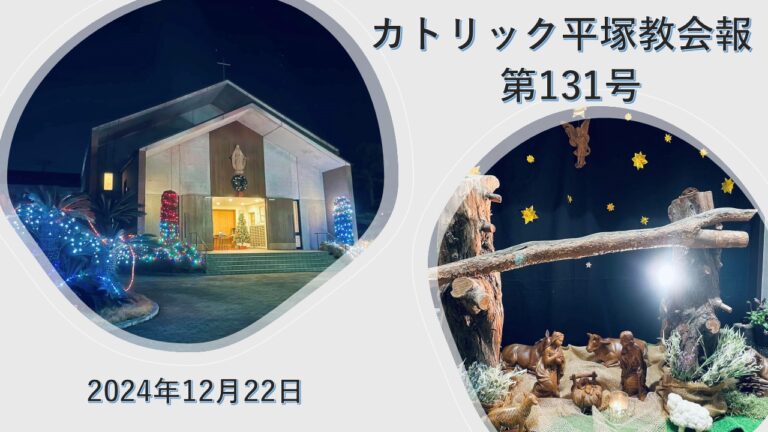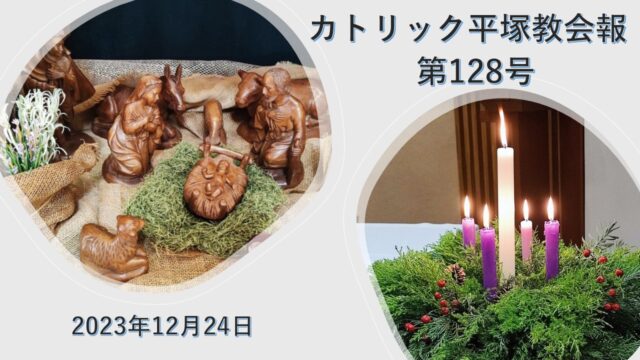カトリック平塚教会報 第126号 2023年4月9日発行
Church Bulletin / Informativo Parroqial

平塚教会主任司祭 トーマス・テハン
生命は静的なものではありません。それは動的なもので、常に変化しています。死や何かを手放すことはその動的な部分の一部です。植物が根付くためには、種は死ななければなりません。わたしたちは毎年春になると、自然の急速な変化を目の当たりにします。新たな命があふれる季節です。春はまさに、私たちキリスト者が、生命、受難、キリストの死と復活を祝うのにふさわしい季節といえます。しかしながら、私たちは日常生活の変化を、イエスの生や死と結びつけて考えているでしょうか。
私たちは、復活されたイエスが、昇天される前に弟子たちの前に現れたことを知っています。このことは、イエスが変化していることを証ししています。亡くなったイエスの肉体は変化して、鍵のかかった部屋に入り、弟子たちと食事をし、様々な場所に現れたことが明らかになります。このことから私たちは、イエスの形が変わられたと推測します。
そして私たちは、最後の晩餐でイエスが行われたことを思い浮かべます。すなわち、イエスがパンをとって、「これはあなたがたのために渡される私のからだである」と言われたこと。また杯をとり、「これはあなたがたと多くの人のために流された私の血である」と言われ、イエスの記念として同じことを行うよう弟子たちに命じたことを思い浮かべます。私たちはこの伝統を、聖体拝領のときに繰り返しています。
イエスとは誰でしょうか。彼は完全に人間であり、また神でもあります。彼は世界の苦しみを引き受けました。彼は自分自身が変わることを受け入れ、私たちを閉じ込めている終わりなき苦しみのサイクルから解放しようとしました。
私たちはしばしば、イエス個人やその再臨に焦点を向けてきました。これは初期の教会の成長の過程でもありました。しかし、キリストのすべてを包みこむ性質によって、イエスの死と復活の意味は普遍的なものに引き上げられたのです。
興味深いことに、使徒信条には、「陰府(よみ)に下り」という言葉があります。これはどのような意味でしょうか。復活したイエスは、彼の前に逝ったすべての人々を神の栄光に導くために、彼らに加わったのです。これは、生きとし生けるものが変化する、すべてを包みこむ活動です。
イエスはキリストの顕現です。キリストは創造の時から神とともにあり、神とともにすべてを支えてきました。イエスは人の子となり、苦しみや死に至るまでのすべてのことを引き受けることによって、それまで受け入れられていた神についての考えを、自らの生涯によって覆したのです。彼は、人と神をどのようにつなげるかを示し、私たちにも同じことをするように促しています。愛と苦しみは、私たちがこのプロセスに入るための、いちばんの方法です。
私たちを含めたすべてのものは、神の愛によるのです。私たちは変わることや手放すことを拒むことによって、しばしばその愛を阻んでいます。もうひとつの障壁は、人間社会の標準と考えられている、因果応報への執着です。つまり、間違ったことには罰が必要であるという考え方です。しかしイエスは、福音の中で誰も罰していません。代わりに、神の慈しみの愛に基づいた、回復をめざす正義について語っています。このことは、処罰のない赦しの可能性を開きます。イエスの使命は、神と創造物の間のあるべき関係を取りもどすことなのです。
私たちも、キリストのうちにいることによって、この使命に加わります。したがって、私たちが聖体拝領の中で得るもっとも大きな贈り物は、私たち自身を変化させる機会をキリストに捧げることなのです。キリストは本当に復活されました、アレルヤ。 (訳:M.U)

Christ is Risen Thomas Tehan
Life is not static. It is dynamic and constantly changing. Dying or letting go is part of that dynamic. The seed must die so that the plant takes root. We all witness each year the rapid changes that takes place in nature in spring each year. New life appears in abundance. It is fitting that we as Christians celebrate the life, passion, death as well as resurrection of Jesus in spring. However do we really connect the ordinary changes in life with the life and death of Jesus?
We are all familiar with appearances of the resurrected Jesus to his apostles before his ascension into heaven. These appearances make clear that Jesus has been transformed. His physical body which died has been transformed and manifests things such as entering a locked room, eating with his disciples and being present in different places. We gather from this that his form has changed.
When we think of what Jesus did at the last supper when he took the bread and said ‘this is my body which is given up for you’ and again taking the chalice ‘this is my blood which will be shed for you and for many’ and he enjoined on them to do this in memory of me. We continue this tradition in our Eucharistic celebrations.
Who is Jesus? He is fully human but also divine. He took on the suffering of the world. He allowed it to change him, and hopefully us so that we would be freed from the endless cycle of projecting out pain elsewhere or remaining trapped inside of it.
Often our focus has been on the individual Jesus and his second coming. This was the process of growth in the early church. However the corporate nature of Christ open up the meaning of Jesus’s death and Resurrection to the universal.
It is interesting to note that in the apostle’s creed the words ‘he descended into hell or the dead’. What does it mean? The resurrected Jesus joins all who have gone before him so that he might lead them into the glory of God. The corporate act of transformation of all living things.
Jesus is the manifestation of Christ. Christ being with God in creation and with God in sustaining everything. Jesus in his life turned the accepted thinking about God on its head by becoming human and taking on all that that entailed to the point of suffering and death. He showed us how to connect the human and divine and invites us to do the same. Love and suffering are out best ways of entering into this process.
Everything is, including ourselves because of God’s love. What often blocks that love is our refusal to change and let go. Another block is the attachment we have to retributive justice, which is considered the norm in human societies. It means that punishment is required where a wrong has been committed. However Jesus never punishes anyone in the gospels. Instead Jesus talks about restorative justice which is based on the loving mercy of God. This opens the possibility of forgiveness without punishment. Jesus’s mission was to restore right relationships between God and his creation.
We participate in that mission by being in Christ. Hence the great gift we have in the Eucharist affording Christ an opportunity to transform us. Christ is truly risen, Alleluia.





